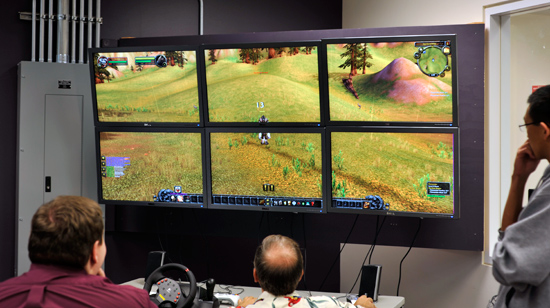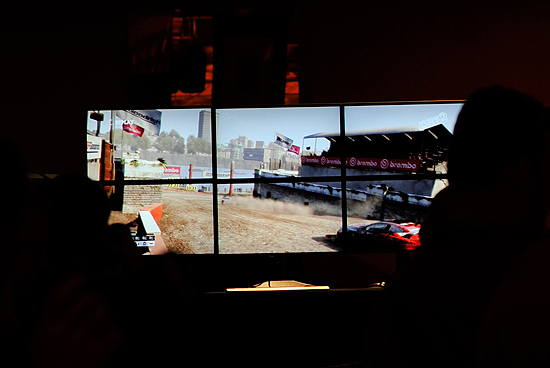Beginnings of the Holodeck: AMD's DX11 GPU, Eyefinity and 6 Display Outputs
by Anand Lal Shimpi on September 10, 2009 2:30 PM EST- Posted in
- GPUs
The First Generation Holodeck by 2016
When AMD first told me about the RV770 they told me another interesting story. For the past several years AMD (and ATI before it) has been obsessed with trying to figure out when it would be possible to render an image so convincing that it was indistinguishable (at least mostly) from reality.
Given the right art and a good technique to render the scene, this is totally possible not only within our lifetimes but within the next decade. Unfortunately, that's not enough.
Carrell estimates that the human eye can directly resolve around 7 million pixels, almost twice the resolution of a 30" display. But that's just what it's directly focusing on, all of the peripherial vision brings the total up to around 100 million pixels. The Eyefinity demo I showed earlier was running at 24.5 million pixels on a single GPU; you can estimate that at this generation we'll be able to do about 50 million pixels with two GPUs and one more generation from now we'll get to that 100 million pixel marker. That's two years for a single GPU. Then give it a few more years to be able to render that many pixels but with enough complexity to actually look real.
Rendering something at the max resolution that the human eye can resolve isn't enough however; you have to feel immersed in the graphics. That's where Eyefinity comes in, at least what it starts to come in.
Carrell believes that in seven years we can have the first generation Holodeck up and running. For those of you who aren't familiar with the Trek reference, Carrell believes it'll take seven years to be able to deliver a 180 degree hemispherical display (you're not completely surrounded by displays but at least your forward and peripheral vision is) with positionally accurate and phase accurate sound (both calculated by the GPU in real time). The GPU will also be used to recognize speech, track gestures and track eye movement/position.
It doesn't solve the issue of not being able to walk forward indefinitely, but again this is only the first generation Holodeck.
Eyefinity isn't anywhere close, but if you understand the direction: it's a start.

We're at six 2560 x 1600 displays today, is it too far fetched to imagine a totally immersive display setup that renders at life-like resolutions?
First person shooters pretty much dictate that you'll need an odd number of displays to avoid your crosshairs spanning multiple monitors. With three displays you can begin to get the immersion effect, but buy five and you'll be completely surrounded by your game. And as I mentioned before, it doesn't require any special application or OS support, the drivers take care of everything: it just appears as a single, large, surface.
It seems trivial but honestly we haven't had the ability to easily support the ridiculous display setups we always see in sci-fi movies. Eyefinity at least makes it look like we can build the PCs from the Matrix.
Will it succeed? Who knows. Does it sound gimmicky? Sure. Is it cool? Yeah, I'd say so.

If panel prices could drop significantly enough where putting together an Eyefinity display setup didn't cost more than the graphics card, I think it'd be a much easier sell. Obviously AMD's next-generation GPU is more than just Eyefinity, but you'll hear about the rest late this month.










137 Comments
View All Comments
Anubis - Friday, September 11, 2009 - link
lol no it cant
zebrax2 - Thursday, September 10, 2009 - link
Well he did say that he played dirt 2 with playable frame ratesaraczynski - Thursday, September 10, 2009 - link
good to see the hardware manufacturers bastardizing moore's law. not only does the technology double in power every 18 months (or whatever), it also suspiciously doubles in price at the same time! well, at least on the new tech to take up the slack for the price halving of the old tech.know of fence - Thursday, September 10, 2009 - link
There is a sweetspot for pixel density (~100 dpi) and minimal viewing distance (~20 inches). More Pixels and bigger screens just means bigger minimal distance from the screen.Unless there are concerns with myopia, big but distant screens don't make much sense for reading or playing. (People beyond 35 tend to pull up and "hug" their monitors anyway.)
Bigger resolutions are interesting for advertisers who don't want their walls of flickering commercials appear blurry when approached.
Also 10 and more megapixels would make it possible to show photographs in native resolution.
There is no point of rendering a plain on a surrounding monitor setup, but rendering a long horizon with 3 monitors could be quite immersive indeed.
A setup of six 16:10 monitors has practically cinemascope aspect ratio 1:2,4. Six 200$ monitors could create a brighter alternative to the projector home cinema experience.
RubberJohnny - Friday, September 11, 2009 - link
"A setup of six 16:10 monitors has practically cinemascope aspect ratio 1:2,4. Six 200$ monitors could create a brighter alternative to the projector home cinema experience"No thanks, i'd take a single 1080p projector over 6 monitors. Whats the point of all that res if you have distracting black bars running through it? LCD manufacturers could make super large, super high res displays right now...if there was demand.
Randomblame - Thursday, September 10, 2009 - link
and I thought my WoW experiance improved when I went to my 24in 1080p monitor now I feel shamed. I must have this....EJ257 - Thursday, September 10, 2009 - link
How about flight sim and motor racing games? This GPU coupled with a curved/wrap-around 100" LCD. How about a 4 GPU "personal supercomputer" setup like the Tesla? =)stevejg61 - Thursday, September 10, 2009 - link
There is one inherent problem that needs to be addressed with the curved, wrap around. It has to have several FOVs, one for each monitor. We ran into this using the Evans & Sutherlin Laser Projector (5Kx4K and 8Kx4K - yes those were real resolutions using 16 PCs). Generally video game will use a single FOV, whereas you would need one for each monitor in reality. The other way is to get distortion correction working for the whole picture, but that involves rendering in an area bigger than the displayed resolution and also doing it on the fly, which will induce a frame lag in rendering.james jwb - Thursday, September 10, 2009 - link
those who've been keeping an eye on Matrox triplehead2go are going to be drooling at this. This is easily the right way to do this.What is the b/w limit of this system, does it have 6 display port's b/w?
drmo - Thursday, September 10, 2009 - link
I would just like to see an FPS that shows you what you would see with peripheral vision. Then I could see the point in having a three monitor setup for games. In real life, I can tell when someone is right beside me, but in an FPS, I can't unless I turn that way. Just having a wider view of what is in front of me doesn't do anything for me.